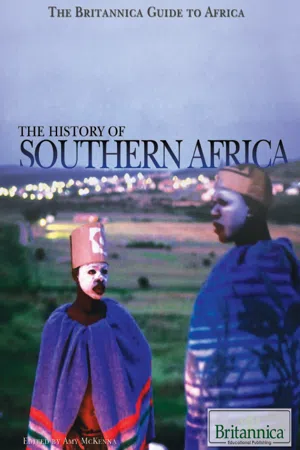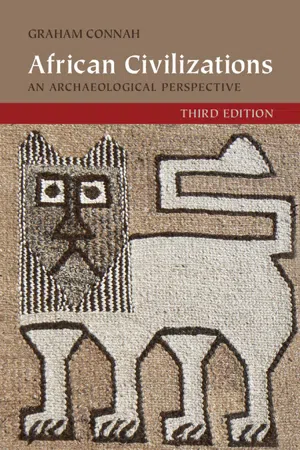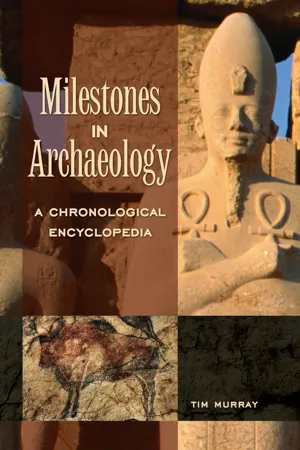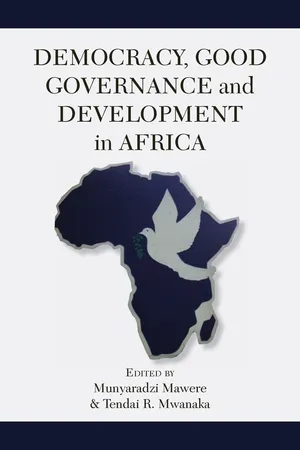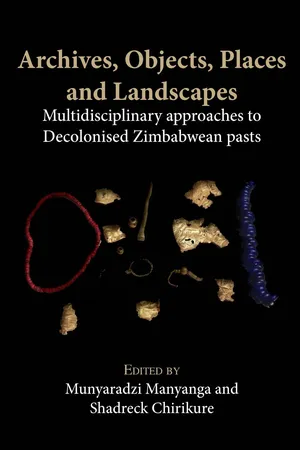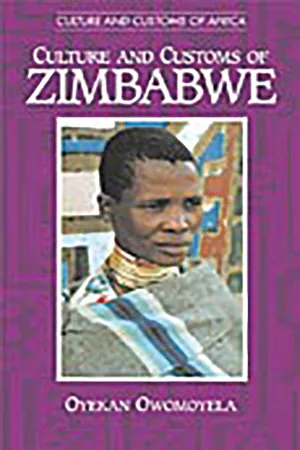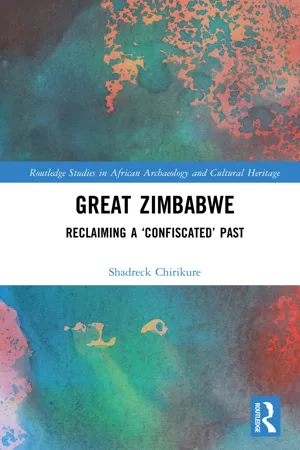History
Great Zimbabwe
Great Zimbabwe was a medieval city in southeastern Africa, known for its impressive stone structures and as a center of trade and culture. It was the capital of the Kingdom of Zimbabwe and flourished between the 11th and 15th centuries. The site is significant for its architectural achievements and its role in the history of the region.
Written by Perlego with AI-assistance
Related key terms
1 of 5
11 Key excerpts on "Great Zimbabwe"
- eBook - ePub
- Britannica Educational Publishing, Amy McKenna(Authors)
- 2010(Publication Date)
- Britannica Educational Publishing(Publisher)
The extensive stone ruin of an African Iron Age city, known as Great Zimbabwe, lies in southeastern Zimbabwe, about 19 miles (30 km) southeast of Masvingo (formerly Fort Victoria). The central area of ruins extends about 200 acres (80 hectares), making Great Zimbabwe the largest of more than 150 major stone ruins scattered across the countries of Zimbabwe and Mozambique.zimbabwe , the country’s namesake, is a Shona word meaning “stone houses.”It is estimated that the central ruins and surrounding valley supported a Shona population of 10,000 to 20,000. With an economy based on cattle husbandry, crop cultivation, and the trade of gold on the coast of the Indian Ocean, Great Zimbabwe was the heart of a thriving trading empire from the 11th to the 15th centuries. The worddaga (The site is generally divided into three main areas: the Hill Complex, the Great Enclosure, and the Valley Ruins. The Hill Complex, which was formerly called the Acropolis, is believed to have been the spiritual and religious centre of the city. South of the Hill Complex lies the Great Enclosure, the largest single ancient structure in sub-Saharan Africa. The Valley Ruins, located between the Hill Complex and the Great Enclosure, include a large number of mounds that are remnants ofearthen and mud-brick) buildings .Great Zimbabwe was largely abandoned during the 15th century. With the city’s decline, its stoneworking and pottery-making techniques seem to have transferred southward to Khami (now also in ruins). Portuguese explorers probably encountered the ruins in the 16th century, but it was not until the late 19th century that the existence of the ruins was confirmed, generating much archaeological research. European explorers who visited the site in the late 1800s believed it to be the legendary city of Ophir, the site of King Solomon’s mines.In the late 19th century numerous soapstone figurines in the form of a bird were found in the ruins; this Zimbabwe Bird later became a national symbol, incorporated into the Zimbabwe flag and shown in other places of high honour.A second great movement of the Bantu peoples began in 1830, this time from the south. To escape from the power of the great Zulu chief Shaka, three important groups fled northward. One of them, the Ndebele, carved out a kingdom. The Ndebele were warriors and pastoralists, in the Zulu tradition, and under their formidable chief Mzilikazi they mastered and dispossessed the weaker groups, known collectively as Shona (Mashona), who were sedentary, peaceful tillers of the land. For more than half a century, until the coming of European rule, the Ndebele continued to enslave and plunder the Shona. During this period, however, British and Afrikaner hunters, traders, and prospectors had begun to move up from the south, and with them came the missionaries. Robert Moffat visited Mzilikazi in 1857, and this meeting led to the establishment in 1861 of the first mission to the Ndebele by the London Missionary Society. - eBook - ePub
National Museums in Africa
Identity, History and Politics
- Raymond Silverman, George Abungu, Peter Probst, Raymond Silverman, George Abungu, Peter Probst(Authors)
- 2021(Publication Date)
- Routledge(Publisher)
Prominent today are the dry stone-built walls (ruins) concealed within a state-protected 720-hectare estate. However, there are over 360 similar, recorded archaeological sites located in Zimbabwe, with a few in the neighboring countries of Botswana, Mozambique and South Africa. 1 Out of the vast possibilities for interpreting Zimbabwe's pastness, controversies surrounding the origins of Great Zimbabwe came to dominate archaeological debates in the twentieth century, epitomizing the politics of the past, and a “genre of colonial archaeology” (Kuklick 1991, 162). The ruins became a conceptual springboard that shaped and re-shaped the representation and governance of archaeological sites and museums (see Garlake 1982 ; Fontein 2006a ; Mataga 2014). The colonial fantasies that the Great Zimbabwe ruins had been built by King Solomon or the Queen of Sheba, or by the Phoenicians or a spattering of other ancient non-African peoples, for gold mining, resulted in the ransacking of stone-walled ruins around the country in the 1890s and early 1900s by explorers and early settlers, particularly those of the Ancient Ruins Company Ltd (Bent 1892 ; Kuklick 1991 ; Matenga 1998). This company was authorized by the British South Africa Company (BSAC) in 1895 to mine all ruins for profit, save for Great Zimbabwe. But Great Zimbabwe was not spared, and under public pressure to stop stone ruins being ransacked, the company was dissolved in 1900 and the Ancient Monuments Protection Ordinance was passed in 1902. 2 Richard Nicklin Hall was appointed the first curator for Great Zimbabwe in 1902, the same year the ordinance was passed. He was supposed to conduct maintenance work and promote tourism - eBook - ePub
Great Zimbabwe
The Iron Age of South Central Africa
- Joseph O. Vogel(Author)
- 2019(Publication Date)
- Routledge(Publisher)
Rhodesian Prehistory 14 (1975): 21-24.Illustrated discussion of the claims made for an ancient association between Great Zimbabwe and the gold fields of King Solomon and the residence of the Queen of Sheba. Explains that the C-14 chronology of Great Zimbabwe is too recent to be associated with ancient times and that resemblances between central African architecture and sometimes cited southern Arabian structures are misleading or erroneously stated.103. Huffman, T. N. "Zimbabwe: Southern Africa's First Town." Rhodesian Prehistory 7.15 (1977): 9-14.Illustrated summary article reconstructing the cultural history of Great Zimbabwe with respect to the economic, ritual and political life of the people living there.104. Huffman, T. N. "Snakes and Birds: Expressive Space at Great Zimbabwe." African Studies 40 (1981): 131-50.Illustrated analysis of the symbolism inherent in the spatial organization of Great Zimbabwe; along with a collation of ethnographic and historical sources detailing social space in southeastern Bantu society. Examines the spatial expression of traditional Shona attitudes about status and life forces and constructs a model for observing evidence of a similar world view in archaeological remains.105. Robinson, K. R. "The Archaeology of the Rozwi." The Zambesian Past . Ed. E. Stokes and R. Brown. Manchester: Manchester University Press, 1966. 3-27.Examination of the archaeological evidence relevant to the period of Rozwi domination in Zimbabwe. Examines the ceramic evidence for continuities and the distribution of zimbabwes in space and time to conclude that the Rozwi developed autochthonously in the south and the center of the associated Zimbabwe culture moved north through time and that the emergence of the Rozwi was coincident with the first walling at Great Zimbabwe. Illustrated with two maps depicting the distribution of sites associated with either the Khami tradition or Zimbabwe culture.106. Summers, R. F. H. Zimbabwe: A Rhodesian Mystery , Johannesburg: Nelson, 1963.General review of the traditional, archaeological and historical evidence from and about Great Zimbabwe and the other stone enclosures.107. Wieschhoff, H. A. The Zimbabwe-Monomatapa Culture in Southeast Africa - eBook - PDF
African Museums in the Making
Reflections on the Politics of Material and Public Culture in Zimbabwe
- Munyaradzi Mawere, Henry Chiwaura, Munyaradzi Mawere, Henry Chiwaura(Authors)
- 2015(Publication Date)
- Langaa RPCIG(Publisher)
295 Heritage at the margins: The limits of representation at Great Zimbabwe The Great Zimbabwe National Monument is approximately 30 km from Masvingo and located in the lowveld in Southern part of Zimbabwe. The monument, built between 1100 and 1450 AD, extends over almost 800 ha and is divided into three groups: the Hill Ruins, the Great Enclosure and the Valley Ruins (Pikirayi 2001, 2006). The site is one of the largest archaeological monument in the country, associated with the dry stone ruins, popularly referred to as “Zimbabwe type” sites (See Pikirayi 2001, 2006).Great Zimbabwe is probably one of the most studied archaeological monuments in Southern Africa. It has captivated the interest of many who have come into contact with it. From the early archive of the Portuguese traders, the 19th century European wanderers, hunters and adventurers to the Cecil John Rhodes and his company the British South Africa Company (BSAC). The site has been studied, excavated, vandalised and appropriated by treasure hunters, pseudo-scientists, antiquarians, historians, anthropologists, professional archaeologists and scientists. The lure of the ‘Great Zimbabwe mystery’ and the ‘Great Zimbabwe controversy’ widely circulated at the turn of the 19 th cetury is still seductive to the man in the street, tourists, politicians and academics with debates and arguments over its origin resurfacing frequently. The site remains one of the most widely contested spaces in the region. The contests range from debates on the origins of the site (Bent 1896 Caton – Thompson 1931 Garlake 1973; Mufuka 1981), different interpretations by archaeologists in the spatial and symbolic functions of the place (Huffman 2011; Pikirayi 2001 Chipunza 1994; Huffman and Voge 1991, as well as competing claims for custodianship by local communities (Fontein 2006, Ndoro 2005). It seems that the “debating Great Zimbabwe” has far from subsided as new evidence, new approaches are deemed to 296 - eBook - PDF
African Civilizations
An Archaeological Perspective
- Graham Connah(Author)
- 2015(Publication Date)
- Cambridge University Press(Publisher)
However, the overall evidence from the various sites that are thought to be culturally related to Great Zimbabwe suggests that there existed a graded series of settlements, from capital city to regional centre to rural village. If this was the case, then it seems likely that a formally organized state did exist on the Zimbabwe Plateau during the second quarter of the second millennium. However, the manner of its emergence remains one of the most significant issues in the archaeology of southern Africa (Kim and Kusimba 2008; Huffman 2010b). Radiocarbon dating and imports from the East African coast, of which ceramics are the most significant, have enabled archaeologists to piece together a reasonably consistent chronology for the zimbabwe-tradition sites of Great Zimbabwe style. This indicates that they had ceased to be important by the end of the fifteenth century and indeed that Great Zimbabwe had declined sharply, at least as an urban centre, by the middle of that century. It used to be thought that the site was virtually abandoned at that time, but it seems more likely that it continued to be inhabited until the nineteenth century, although it had lost both its economic and political importance and most of its population (Huffman and Vogel 1991: 69; Collett et al. 1992: 157–8; Sinclair et al. 1993: fig. 43.2). However, more attention needs to be given to the archaeology of Great Zimbabwe concerning the period after about 1450 (Pikirayi 2013a). Social complexity in Zambezia 281 Documentary and oral sources indicate that the kingdom of the Mwene Mutapa, on the northern end of the Zimbabwe Plateau, was the immediate successor of the state that had been centred on Great Zimbabwe, and archaeo- logical research has provided some support for this. In the Mount Fura area, Innocent Pikirayi investigated sites which he identified with the Mutapa state. - eBook - PDF
Milestones in Archaeology
A Chronological Encyclopedia
- Tim Murray(Author)
- 2007(Publication Date)
- ABC-CLIO(Publisher)
Its ruler lived in the hilltop complex surrounded by extended family groups. Its inhabitants herded cattle, farmed sorghum and millet, and de- pended on food tributes from surrounding farming communities, which are estimated to have had around 3,000 to 6,000 people. To extract this tribute members of the ruling family would be installed as local leaders. It is argued that the decline of Great Zimbabwe was the result of environ- mental degradation, caused by deforestation and depletion of soil fertility because of the demands of its urban population, at its peak numbering be- tween 12,000 and 15,000 people. The site was abandoned ca. AD 1500, its in- habitants moving on to the more fertile high plains of Zimbabwe, from which they were excluded during European colonization. See also Publication of The Desert Fayum (1934); Southeastern and Southern Africa during the Iron Age: the Chifumbaze Complex (1960–1980). Further Reading Caton-Thompson, G. 1931. The Zimbabwe culture: ruins and reactions. Oxford: Claren- don Press. Caton-Thompson, G. 1931. The Zimbabwe culture: ruins and reactions. 2nd ed. With a new introduction. London: Cass, 1971. Caton-Thompson, G. 1983. Mixed memoirs. Gateshead, UK: Paradigm Press. 398 > Milestones in the Twentieth Century and Beyond Publication of Greek Sculpture and Painting to the End of the Hellenistic Period (1932) Sir John Davidson Beazley (1885–1970) was a graduate of and later the Lin- coln Professor of Archaeology at Oxford University. He was an excellent clas- sical scholar but his primary interest was in Greek art and Attic vase painting. Vase painting, because of its quality and the fact it had survived when all other forms of painting in ancient Greece did not, made it particularly im- portant to the history of art. - eBook - PDF
- Munyaradzi Mawere, R. Mwanaka, Munyaradzi Mawere, R. Mwanaka(Authors)
- 2015(Publication Date)
- Langaa RPCIG(Publisher)
315 Chapter Eleven The Unsung Dimension of Great Zimbabwe National Monument: A critique Tapuwa Raymond Mubaya, Munyaradzi Mawere &Joshua Chikozho Introduction Several thousands of visitors from diverse backgrounds are flocking each year to Great Zimbabwe National Monument to witness the physical remains of an unparalleled and sophisticated indigenous civilisation that has stood the test of time. What seems to be hidden to many of these visitors is that there is more to Great Zimbabwe National Monument than what physically meets the eye. For the past centuries and decades scholars, particularly from the fields of archaeology and history, have long tangled and grappled with the conflicting historical narratives of the site as well the archaeology and authorship of the site (see for instance, Garlake 1975, 1982; Bent 1971). Many other heritage and archaeology scholars who have looked at heritage site have also grappled with religious dimension (Mawere, Mubaya & Sagiya 2012), symbolism and management of the site (Matenga 1998; Ndoro 2001; Pwiti & Chirikure 2008), and politics surrounding the site (Fontein 2006), among other such aspects. Insignificant attention has been given to try to understand and unpack the perceived intellect, skills and expertise or in other words, the indigenous knowledge systems (IKSs) that masterminded and propelled such self-imposing and impressive dry stone structures of enormous magnitude. We argue that the dry stone structures together with their associated earthen dhaka platforms alone without incorporating the unsung indigenous knowledge (IK) that were used to put up such magnificent structures have presented and will always present an incomplete 316 story of Great Zimbabwe National Monument. This probably explains why the burial site that was used by the people who resided at Great Zimbabwe during its occupational period still remains a puzzle to be resolved and so is the issue of waste management. - eBook - PDF
Archives, Objects, Places and Landscapes
Multidisciplinary approaches to Decolonised Zimbabwean pasts
- Munyaradzi Manyanga, Shadreck Chirikure, Munyaradzi Manyanga, Shadreck Chirikure(Authors)
- 2017(Publication Date)
- Langaa RPCIG(Publisher)
The data presented here add to our increasing body of knowledge on the Zimbabwe culture. It is anticipated that more research will address issues of the social, 164 political and economic links between Ndongo and other Zimbabwe culture sites in the region. References Bvocho, G. (2001) ‘A study of ornaments from Mwenezi and Malumba, south-eastern Zimbabwe’, unpublished BA dissertation, University of Zimbabwe. Collett, D.P., Vines, A. and Hughes, G. (1992) ‘Dating and chronologies of the Valley Enclosures: implications for the interpretation of Great Zimbabwe’, African Archaeological Review, 10: 139 61. Chipunza, K.T. (1994) A Diachronic Analysis of the Architecture of the Hill Complex at Great Zimbabwe , Uppsala: Societas Archaeologica Upsaliensis. Chirikure, S. and Pikirayi, I. (2008) ‘Inside and outside the dry stone walls: revisiting the material culture of Great Zimbabwe’, Antiquity, 82: 976–993. Garlake, P. (1973) Great Zimbabwe , London: Thames and Hudson. Garlake, P. (1976) ‘An investigation of Manyikeni, Mozambique’, Azania: Archaeological Research in Africa, II(I): 25 47. Gelfand, M. (1977) The Spiritual Beliefs of the Shona. A Study Based on Fieldwork among the East-Central Shona, Gweru: Mambo Press. Gelfand, M., Mavi, S., Drummond, R.B. and Ndemera, B. (1985) The Traditional Medical Practitioner in Zimbabwe , Gweru: Mambo Press. Huffman, T.N. (1996) Snakes and Crocodiles: Power and Symbolism in Ancient Zimbabwe , Johannesburg: Witwatersrand University Press. Huffman, T.N. (2007) Handbook to the Iron Age: The Archaeology of Pre-Colonial Farming Societies in Southern Africa, Scottsville: University of KwaZulu-Natal Press. Huffman, T.N. and Vogel, J.C (1991) ‘The chronology of Great Zimbabwe’, South African Archaeological Bulletin, 46: 61 70. Küsel, M.M. (1992) ‘A preliminary report on settlement layout and gold melting at Thulamela: a Late Iron Age site in the Kruger National Park’, Koedoe, 35(1): 55 64. - eBook - PDF
- Oyekan Owomoyela(Author)
- 2002(Publication Date)
- Greenwood(Publisher)
4 Art, Cinema, and Architecture ZIMBABWE'S ARTISTIC HERITAGE includes the ancient rock paintings that are scattered over wide areas of the country and the magnificent architecture of the Great Zimbabwe. The ancient sculptural skill evident in the so-called Zimbabwe birds found in the ruins of the Great Zimbabwe monument per- sists today in the works of numerous accomplished sculptors, some ranking among the best in the world. The people also demonstrate their creativity in their crafting of materials for everyday use: pots for cooking and water stor- age, fabrics (for which they employ fibers, grasses, and reeds), and headrests, to name a few. In this connection we might mention their habit of decorat- ing their dwellings with artistic motifs. SCULPTURE Whereas sculpture abounds in some parts of Africa, for example as representa- tions of gods, it is relatively uncommon in southern Africa, although groups like the Venda and the Thonga-Shangane do produce some figurative wood carvings. In general, material arts in southern Africa are functional and per- sonal, rather than symbolic or decorative. While the Shona traditionally worked iron and carved wood figures, they did not produce masks or symbolic sculp- ture. The iron and wood objects were (and are) employed mainly in the con- texts of male initiation (where they serve as visual aids in sexual instruction), divination, and healing. They are also used as household and field sentinels. The presence of some stone sculpture, in particular of soapstone birds, at the Great Zimbabwe bears witness to an ancient tradition of sculpture 62 CULTURE AND CUSTOMS OF ZIMBABWE among the Shona, and surviving artifacts from the area are also on display in museums in London and Cape Town. But the tradition has not survived to modern times, Zimbabwe's new, world-famous sculpture owing its begin- ning to the interest of mission school teachers who after World War II taught their pupils to carve wood reliefs and rounded figures. - eBook - ePub
Historical Archaeology
Back from the Edge
- Pedro Paulo A. Funari, Martin Hall, Sian Jones, Pedro Paulo A. Funari, Martin Hall, Sian Jones(Authors)
- 2013(Publication Date)
- Routledge(Publisher)
The peoples of the Zimbabwe Plateau first came into contact with European traders at the beginning of the sixteenth century. Although the northern parts of the plateau had long been trading with the coastal Swahili prior to this contact, the region was firmly placed in the realm of European mercantilist capital with the arrival of the Portuguese at Sofala on the Mozambican coast around AD 1500. A wealth of documentary information exists, some of which can be used to interpret archaeological evidence dating to this period. Subsequent population movements and shifts in various parts of the Zimbabwe Plateau, some of which were connected to the Portuguese presence in northern Zimbabwe, are recalled in Shona oral traditions, a few of which can be used to understand the archaeological remains connected to the later Shona.After the sixteenth century, the Zimbabwe Plateau and adjacent valley and desert margins to the north, south and west witnessed tremendous change in terms of the demise of states of the Great Zimbabwe–Khami culture system. The demise of the Changamire–Rozvi state connected with complex, elite centres such as Naletale and Danangombe is perhaps linked to the arrival of mostly non-Shona groups from the south of the Limpopo, such as the Ndebele, Ngoni and the Sotho–Tswana. Other groups passed through the Zimbabwe plateau proper on their way northwards, or settled permanently in the peripheral areas. The Ndebele are largely documented by early missionaries, hunters, concession seekers and even through irregular contacts with the Dutch from the northern Transvaal. Archaeologically they can be identified through some of their capitals such as Bulawayo, other lesser towns and numerous villages. Research into the archaeology connected with the Ndebele in Zimbabwe is still in its infancy.All these events present tremendous potential for the discipline of historical archaeology in Zimbabwe, a field with a very broad, but largely untapped, scope. The historical period has largely been left to the historians, but it appears that a multi-disciplinary approach to the study of even the more recent past is required. Archaeology can amplify data even in situations where historical documentation appears to provide a complete account of the past. The Ndebele and Mutapa states are clear examples of where inter-disciplinary research can be especially fruitful, but there are other areas in Zimbabwe which can be studied by employing the same methods. - eBook - ePub
Great Zimbabwe
Reclaiming a 'Confiscated' Past
- Shadreck Chirikure(Author)
- 2020(Publication Date)
- Routledge(Publisher)
masvingo was of a similar style. While dry stone walls created partitions between houses or links to create enclosures, solid dhaka walls fulfilled the function in areas without dry stone walls (see Caton-Thompson 1931; Chirikure et al. 2017). This confirms the observation made by Whitty (1961) that Great Zimbabwe is an accretion of multi-building homesteads belonging to different time periods. While there was continuity in some respects, there was also change in others, showing the dynamism of practice through space and time. Perhaps the most important question is: what activities were undertaken by various homesteads, diachronically and synchronically? While this question is pursued in the following chapters, the next section is dedicated to understanding the raw materials that were used to build different homesteads at Great Zimbabwe, as a prelude to thinking about issues related to individual household and communitarian labour.Figure 5.4 Layout of houses outside the walls (redrawn from Huffman 2007).Materials, techniques, and typologies: exploring dry stone walls and house structures within Great Zimbabwe
Great Zimbabwe is located on and around lands dominated by granite hills of assorted typologies (Garlake 1973; Bannerman 1982; Pikirayi 2001; Ndoro 2001; Musindo 2019). Amidst this diversity, some of the granite formations are large, smooth, bare, and rounded, while others are irregularly shaped and form small and big boulders. As far as the rounded and flat ones are concerned, daily and nightly temperature fluctuations has precipitated the flaking of the rocks to form flat, parallel-sided slabs that often slid down the hill slopes and collected as scree at the bottom (Garlake 1973; Twidale 2012). These were then hammered to rectangular and square-shaped blocks (mabwe ) for constructing dry stone walls. Other than this natural raw material, the available evidence shows that the builders of Great Zimbabwe extracted granite from quarries scattered in various localities around the site (Ndoro 2001). The process of stone quarrying involved heating the parent rock to very high temperatures, accompanied by quenching with water to crack through thermal stress, thereby producing thin slabs of rock. The resulting slabs were then worked with stone hammers and wedges to create cuboidal ‘brick-like’ stone blocks with parallel tops and bottoms, vertical sides, and a standard thickness (Garlake 1973; Walker 1993). Individual mabwe
Index pages curate the most relevant extracts from our library of academic textbooks. They’ve been created using an in-house natural language model (NLM), each adding context and meaning to key research topics.
